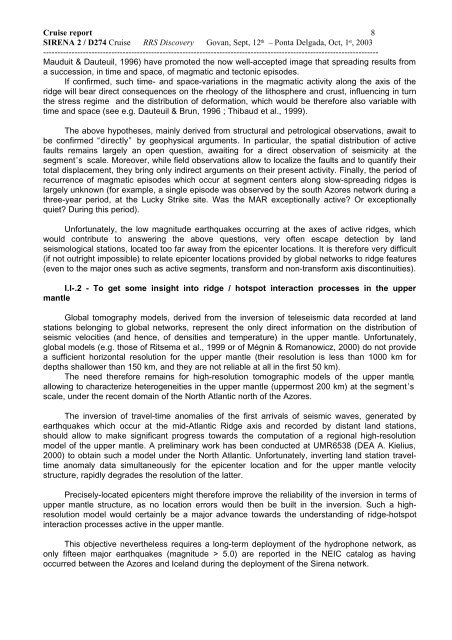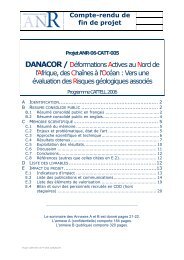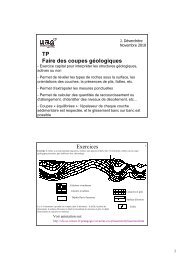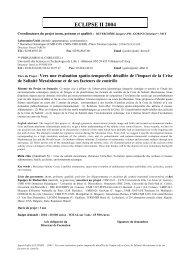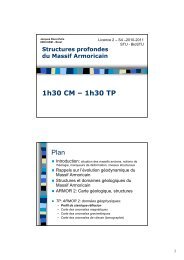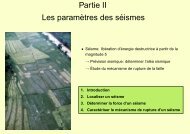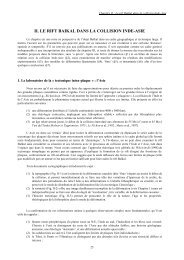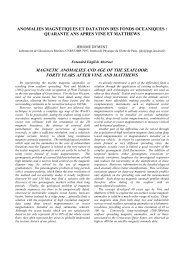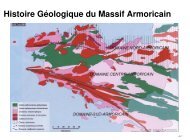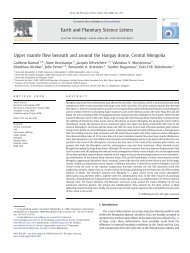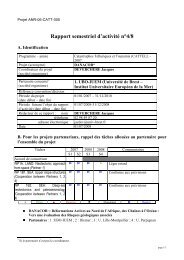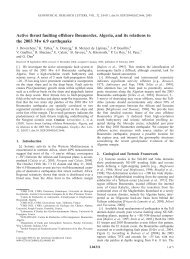Cruise Report - liste des personnes ayant une page web - Université ...
Cruise Report - liste des personnes ayant une page web - Université ...
Cruise Report - liste des personnes ayant une page web - Université ...
- No tags were found...
You also want an ePaper? Increase the reach of your titles
YUMPU automatically turns print PDFs into web optimized ePapers that Google loves.
<strong>Cruise</strong> report 8SIRENA 2 / D274 <strong>Cruise</strong> RRS Discovery Govan, Sept, 12 th – Ponta Delgada, Oct, 1 st , 2003----------------------------------------------------------------------------------------------------------------------Mauduit & Dauteuil, 1996) have promoted the now well-accepted image that spreading results froma succession, in time and space, of magmatic and tectonic episo<strong>des</strong>.If confirmed, such time- and space-variations in the magmatic activity along the axis of theridge will bear direct consequences on the rheology of the lithosphere and crust, influencing in turnthe stress regime and the distribution of deformation, which would be therefore also variable withtime and space (see e.g. Dauteuil & Brun, 1996 ; Thibaud et al., 1999).The above hypotheses, mainly derived from structural and petrological observations, await tobe confirmed “directly” by geophysical arguments. In particular, the spatial distribution of activefaults remains largely an open question, awaiting for a direct observation of seismicity at thesegment’s scale. Moreover, while field observations allow to localize the faults and to quantify theirtotal displacement, they bring only indirect arguments on their present activity. Finally, the period ofrecurrence of magmatic episo<strong>des</strong> which occur at segment centers along slow-spreading ridges islargely unknown (for example, a single episode was observed by the south Azores network during athree-year period, at the Lucky Strike site. Was the MAR exceptionally active? Or exceptionallyquiet? During this period).Unfortunately, the low magnitude earthquakes occurring at the axes of active ridges, whichwould contribute to answering the above questions, very often escape detection by landseismological stations, located too far away from the epicenter locations. It is therefore very difficult(if not outright impossible) to relate epicenter locations provided by global networks to ridge features(even to the major ones such as active segments, transform and non-transform axis discontinuities).I.I-.2 - To get some insight into ridge / hotspot interaction processes in the uppermantleGlobal tomography models, derived from the inversion of teleseismic data recorded at landstations belonging to global networks, represent the only direct information on the distribution ofseismic velocities (and hence, of densities and temperature) in the upper mantle. Unfortunately,global models (e.g. those of Ritsema et al., 1999 or of Mégnin & Romanowicz, 2000) do not providea sufficient horizontal resolution for the upper mantle (their resolution is less than 1000 km fordepths shallower than 150 km, and they are not reliable at all in the first 50 km).The need therefore remains for high-resolution tomographic models of the upper mantle,allowing to characterize heterogeneities in the upper mantle (uppermost 200 km) at the segment’sscale, under the recent domain of the North Atlantic north of the Azores.The inversion of travel-time anomalies of the first arrivals of seismic waves, generated byearthquakes which occur at the mid-Atlantic Ridge axis and recorded by distant land stations,should allow to make significant progress towards the computation of a regional high-resolutionmodel of the upper mantle. A preliminary work has been conducted at UMR6538 (DEA A. Kielius,2000) to obtain such a model under the North Atlantic. Unfortunately, inverting land station traveltimeanomaly data simultaneously for the epicenter location and for the upper mantle velocitystructure, rapidly degra<strong>des</strong> the resolution of the latter.Precisely-located epicenters might therefore improve the reliability of the inversion in terms ofupper mantle structure, as no location errors would then be built in the inversion. Such a highresolutionmodel would certainly be a major advance towards the understanding of ridge-hotspotinteraction processes active in the upper mantle.This objective nevertheless requires a long-term deployment of the hydrophone network, asonly fifteen major earthquakes (magnitude > 5.0) are reported in the NEIC catalog as havingoccurred between the Azores and Iceland during the deployment of the Sirena network.


